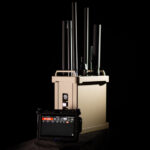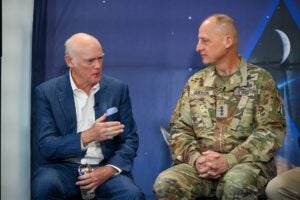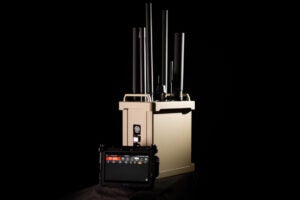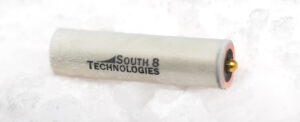
The new head of the Trump administration’s Golden Dome initiative recently outlined his near-term goals, noting space-based interceptors (SBIs) will be the hardest technical challenge, and clarified the architecture and threat have not yet been decided on.
“Our near term focus is going to be on integration of command and control of the various assets that have been built across all those stovepipes…that includes the sensors, that includes the shooters, as well as the [communication pipes]. How do we bring all of that to bear simultaneously in protection of the homeland while utilizing the capabilities that are already there and not trying to recreate them,” Space Force Gen. Mike Guetlein said during the July 22 Space Foundation’s Innovate Space Global Economic Summit.

Guetlein compared this to the earlier vision of Joint All-Domain Command and Control (JADC2), seeking to connect sensors and shooters from all the military branches into a single larger network.
He said they have to deliver on this vision of integrated command and control across the country with an integrated network of sensors to be able to close the fire control loop with an integrated network of interceptors “that have probably never been brought together before between the Army, the Navy and the Air Force and the Marine Corps. That will be our challenge right out of the gate.”
Guetlein underscored the group he is building plans to craft a schedule such that they have demonstrations every six months so that they can deliver within the short three year timeline imposed by President Donald Trump.
“That means we need to move out with a sense of urgency and move out with incremental wins along the way to make sure that we’re on a vector to deliver the capability that he’s asked us to deliver.”
In May, Trump announced Golden Dome would cost a total of $175 billion, be fully operational within three years, include space-based interceptors, and announced Guetlein would lead the program (Defense Daily, May 20).
The Senate confirmed Guetlein on July 17, so his new title is the Golden Dome for America Direct Reporting Program Manager (GDA DRPM), reporting directly to Deputy Secretary of Defense Steve Feinberg.
Beyond the short term, Guetlein admitted space-based interceptors will probably be the most technically challenging element of Golden Dome and whether it can be built economically and at scale.
“I think C2 technically is going to be challenging but I think we’re going to overcome it in short order. I think the real technical challenge will be building of the space-based interceptor. That technology exists, I believe. I believe we have proven every element of the physics, that we can make it work, but [what] we have not proven is, first, can I do it economically? And then second, can I do it at scale? Can I build enough satellites to get after the threat, can I expand the industrial base fast enough to build those satellites? Do I have enough raw materials, etc? So that will be our biggest challenge I think technically.”
Trump’s May announcement claimed the program will “truly be completing the job that President Reagan started 40 years ago, forever ending the missile threat to the American homeland. And the success rate is very close to 100 percent which is incredible, when you think of it, you’re shooting bullets out of the air.”
That original Strategic Defense Initiative, to include SBIs, was ultimately abandoned as the technology did not support space and ground-based interceptions of hundreds or thousands of nuclear warheads from missiles.
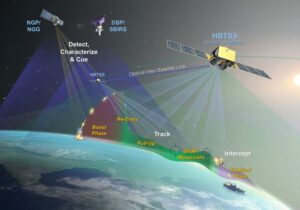
Despite the administration estimating Golden Dome will cost $175 billion, a May 5 Congressional Budget Office report estimated the costs of just deploying the space-based interceptors would cost anywhere between $161 billion to $831 billion depending on how many interceptors are needed against how large of a threat.
Open source researchers from the Federaton of American Scientists estimate North Korea could have enough material for 50 to 100 nuclear weapons while Russia’s 2022 New Strategic Arms Reduction Treaty declaration said it deployed 1,549 strategic nuclear warheads on 540 strategic delivery systems, or ICBMs, submarine-launched ballistic missiles and heavy bombers.
While the administration’s initial statements on Golden Dome claim it will protect against all missile attacks on the U.S. homeland, with SBI’s as one part of that, Guetlein argued the Golden Dome architecture and threats they plan to defeat have not been decided.
“I will tell you there are a lot of people speaking in the public about what they think the threat is and what they think Golden Dome is and etcetera, and I will tell you I have not built an architecture to date. So, everybody who’s telling you they think they know, do not know, including me. I will also tell you that there’s a lot of people talking about the threats they think we have to go after that are also uninformed.”
Guetlein said he planned to speak with Gen. Gregory Guillot, commander of U.S. Northern Command (NORTHCOM), and Gen. Stephen Whiting, commander of the U.S. Space Command, during a visit to NORTHCOM on July 24 to help narrow down those issues.
He said the talks would focus on “what is the problem that we’re trying to solve because that is the why we’re here, that’s going to define the size of the architecture, that is going to define the size of the organization that we’ve got to build, etcetera. And then based on that objective architecture, can we effectively counter that threat that we define in 2028? That’s what we have to do, that’s how we’re defining success.”

 By
By 


